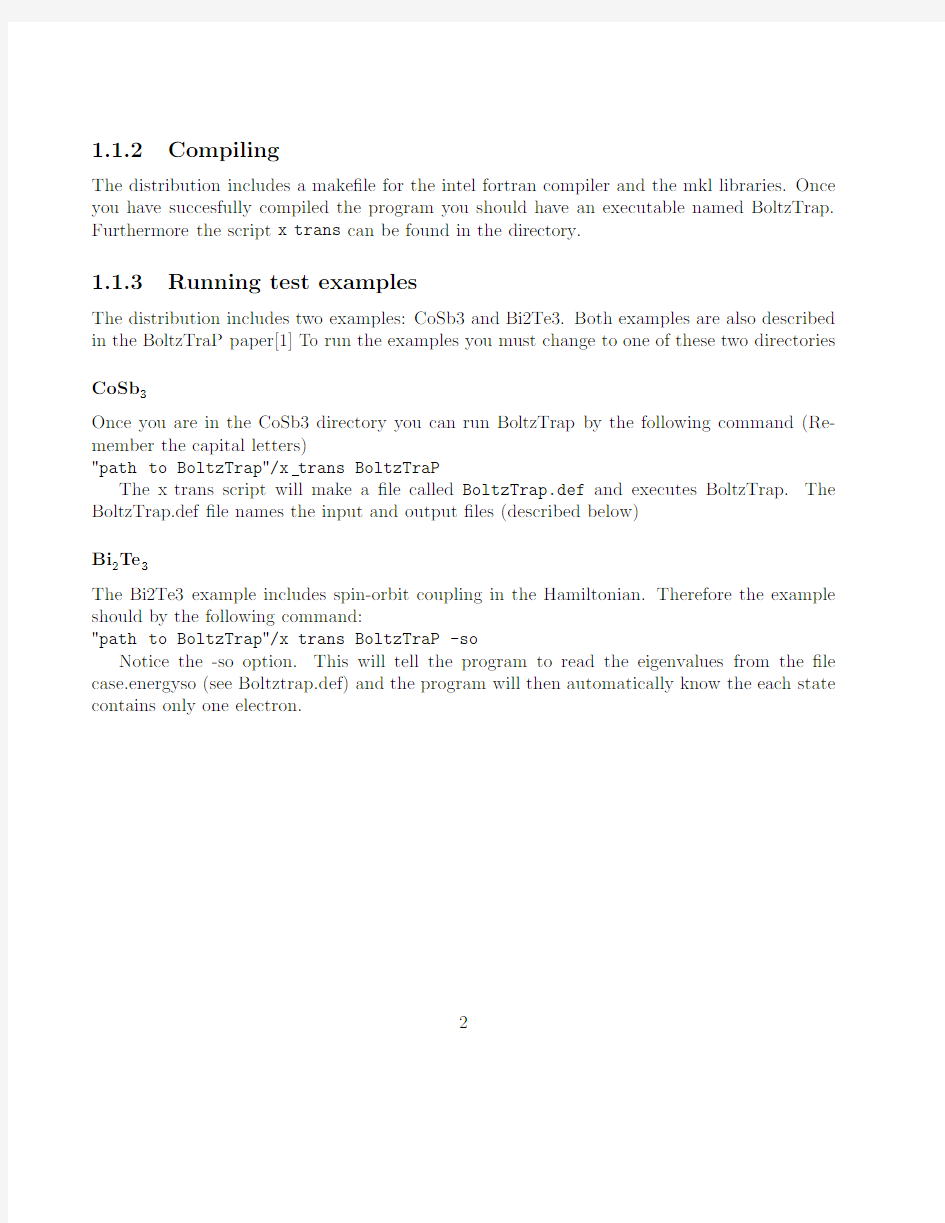BolztrapUserGuide


Chapter1
BoltzTraP
This package contains the program Boltz mann Tra nsport P roperties(BoltzTraP)for calculat-ing the semi-classic transport coe?cients.It can be obtained from www.icams.de/boltztrap. The program has documented in https://www.360docs.net/doc/282193238.html,mun.[1]If you publish results obtained using the program this paper should be sited.
The program was originally interfaced to the WIEN2k code,but can easily be interfaced to other bandstructure codes.Marcos Alves and Matthieu Verstraete have provided Siesta and ab-init interfaces.This?le format is documented at the end of this?le.Please contribute if you make such an interface.
1.1Getting started
1.1.1Unpacking
Run the command bunzip2BoltzTraP.tar.bz2;tar xvf BoltzTrap.tar
This will unpack several directories
src The source code
test Example?les,Al,Bi2Te3and CoSb3
doc This?le
util A perl script to gather WIEN energy?les
1
1.1.2Compiling
The distribution includes a make?le for the intel fortran compiler and the mkl libraries.Once you have succesfully compiled the program you should have an executable named BoltzTrap. Furthermore the script x trans can be found in the directory.
1.1.3Running test examples
The distribution includes two examples:CoSb3and Bi2Te3.Both examples are also described in the BoltzTraP paper[1]To run the examples you must change to one of these two directories CoSb3
Once you are in the CoSb3directory you can run BoltzTrap by the following command(Re-member the capital letters)
"path to BoltzTrap"/x trans BoltzTraP
The x trans script will make a?le called BoltzTrap.def and executes BoltzTrap.The BoltzTrap.def?le names the input and output?les(described below)
Bi2Te3
The Bi2Te3example includes spin-orbit coupling in the Hamiltonian.Therefore the example should by the following command:
"path to BoltzTrap"/x trans BoltzTraP-so
Notice the-so option.This will tell the program to read the eigenvalues from the?le case.energyso(see Boltztrap.def)and the program will then automatically know the each state contains only one electron.
2
1.2
Using the program 1.2.1Input ?les
To run the program you must have a ?le describing the parameters for BoltzTraP named case.intrans (where case is the name of the directory).Furthermore you need a ?le with the band-structure and the crystal structure,case.energy(so)and case.struct,where case is the name of the directory.Presently case.energy(so)and case.struct have to be in the format of the WIEN2k code.
0000.0
isetfermi idebug setgap gapchange isetfermi >0set fermilevel to middle of gap idebug sets the level of output setgap=1will force the gap to be gapchange (in Ry)0.554750.00050.4240.
Fermilevel (Ry),deltae,ecut,number of valence electrons deltae determines the stepsize of the DOS grid ecut gives the range around efermi in which the bands are included CALC
CALC (calculate expansion coe?,Eq.(p1),NOCALC (read from ?le)5
lpfac,number of latt-points per k-point lpfac=5:?ve times as many R points are used as k points were input BOLTZ
run mode (only BOLTZ is supported).15
efcut.energy range of chemical potential around efermi that is used for integrals (Eqs.(p12-p15))800.
50.Tmax,temperature grid -1
Energyrange of bands given individual DOS output sig xxx and dos xxx (xxx is band number).Negative:no individual DOS.HISTO scheme to obtain DOS.HISTO/TETRA:histogram/thetrahedron[2]sampling
Table 1.1:Input ?le for CoSb 3.The Equations refer to the paper[1].
1.2.2Output ?les.BOLTZ option
The traces of the conductivity tensors are written as a function of μand T in the ?le called case.trace.You must write your own program/script to extract the information you need.The last columns were added after the paper was accepted and are the electronic speci?c heat c c (T ;μ)= n (ε)(ε?μ) ?f μ(T ;ε)?T
dε(1.1)3
column12345678910 quantityμT N n(μ)Sσ/τR Hκ0cχunit Ry K e/uc e/uc V/K1/(?m s)m3/C W/(m K s)J/(mol K)m3/mol
Table1.2:Output in case.trace
and the Pauli magnetic susceptibility
χ(T;μ)=μ0μ2
B
n(ε)
?
?fμ(T;ε)
?ε
dε(1.2)
The program outputs the individual components of the conductivity tensors(?les case.condtens and case.halltens).The?rst three colums are like in the case.trace?le.
In case.condtens next nine colums are theσ/τcomponents(3x3tensor).These are followed by the nine Seebeck components and?nally the nineκ0components.
In case.halltens27columns follow(The Hall tensor is3x3x3tensor)
The coordinate-system used is de?ned so that the x axis is parallel to the crystallographic a-axis(of the conventional cell).The y-axis lies in the crystallographic ab plane and is orthogonal to the x-axis and the z-axis is orthogonal to the x and y axes.If you want a di?erent coordinate system you must work out the appropriate transformation yourself(a good reference is”J.F. Nye,Physical Properties of Crystals”).The axes setup is done in the subroutine latgen2.f.
4
1.3Frequently Asked Question
How many k-points should I use for a transport calculation.
This of-course depends on your system,but generally“a lot”.A rule of thumb is that your convergence tests should start at16×106/V puc,where V puc is the volume of the primitive unit cell.Please note that you do not need to redo the full scf cycle with the dense k-mesh
I have calculated my energy?les in parallel how do I include them in BoltzTraP The utility
gather energy.pl
will stick your case.energy(so)*into one case.energy(so)?le that can be fed into BoltzTrap How can I calculate the conductivity.
One can only calculate the conductivity if one knowsτ.The distribution includes a calculation for Al for which Ashcroft and Mermin[3]listρ=2.45μ?cm=2.45×10?8?m(page8).If you look in Table1.2you’ll see that BoltzTraP outputsσ/τ.At270K one obtainsσ/τ≈3.17×1021(?m)?https://www.360docs.net/doc/282193238.html,ingτ=0.8×10?14s(page9)one get for the resistivityρ=1/(3.17×1021·0.8×10?14)=3.9×10?8?m which is a nice agreement considering the large uncertainty inτ(Ashcroft and Mermin use free electron bands)
5
1.3.1File format description for the GENE?le format
This is version1.0of the speci?cation,which is implemented in BoltzTraP1.2.0,abinit6.6,
and current siesta release(v x.y.z).
2?les should be input to BT-one for crystal structure and symmetry operations and
another for electronic eigenvalues.This document describes the alternative format produced
by siesta,abinit,pwsic,and vasp.Both?les are read in generic_band.F90
STRUCTURE FILE:
Version line,specified as a real number x.y+string,e.g.
1.0version of the Boltztrap file format
direction cosines(3lines3real numbers)
number of symmetry operations(integer)
for each symmetry operator
symmetry operations.One pr line which will be read as((iz(j1,j2,j),j2=1,3),j1=1,3) EIGENVALUE FILE:
Version line,specified as a real number x.y+string,e.g.
1.0version of the Boltztrap file format
Number of k-points(integer)
For each k-point
k-point(3real)number of bands(integer)
k-point in reduced coordinates with respect to the primitive cell
For each band
eigen energy in Rydberg(real)
6
Bibliography
[1]Madsen,G.K.H.;Singh,https://www.360docs.net/doc/282193238.html,mun.2006,175,67-71.
[2]Bl¨o chl,P.;Jepsen,O.;Andersen,O.K.Phys.Rev.B1994,49,16223-16233.
[3]Ashcroft,N.W.;Mermin,N.D.Solid State Physics.Saunders College Publishing,Orlando,
Florida,1976.
7
